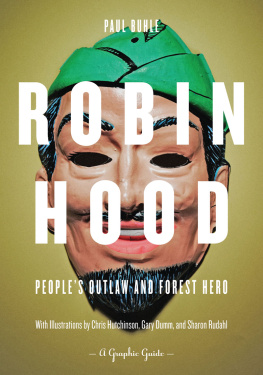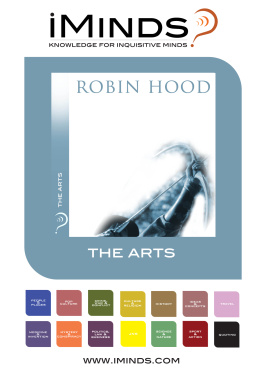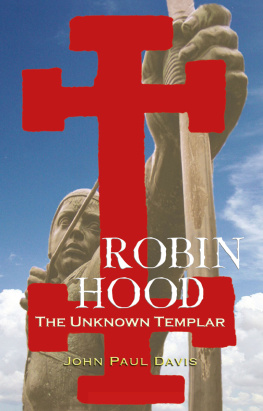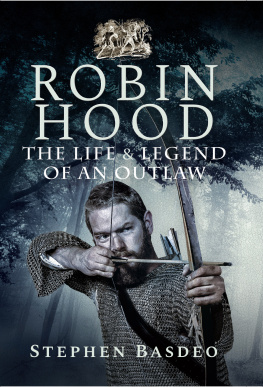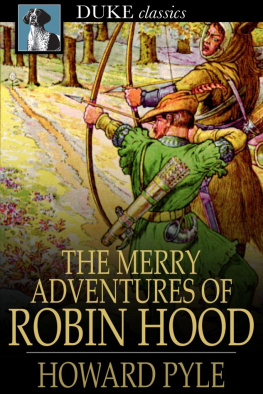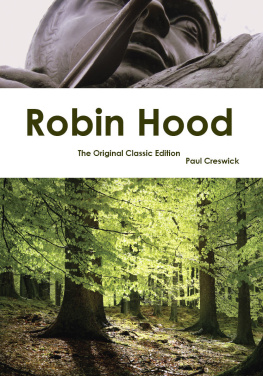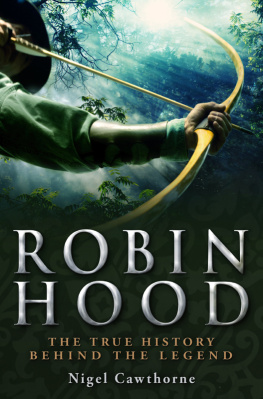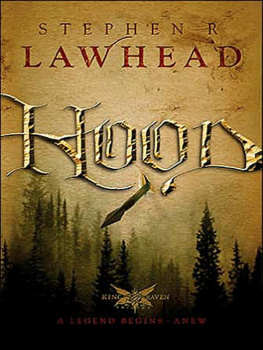Robin Hood: Peoples Outlaw and Forest Hero; A Graphic Guide
Paul Buhle with illustrations by Chris Hutchinson, Gary Dumm and Sharon Rudahl
This edition 2011 PM Press
All rights reserved. No part of this book may be transmitted by any means without permission in writing from the publisher.
ISBN: 9781604863185
Library of Congress Control Number: 2010916481
Cover by John Yates / www.stealworks.com
Back cover image: CLR James The Midnight Robber banner by Mike Alewitz 5 x 7 /2010 www.alewitz.com
Interior design by briandesign
10 9 8 7 6 5 4 3 2 1
PM Press
PO Box 23912
Oakland, CA 94623
www.pmpress.org
Printed in the USA on recycled paper, by the Employee Owners of Thomson-Shore in Dexter, Michigan.
www.thomsonshore.com
Contents
Acknowledgments
Much thanks to the editors and production folks at PMespecially Ramsey Kanaan, Romy Ruukel, Gregory Nipper, and Brian Layngand to the critics of the text who generously gave us criticisms on matters large and small: Kent Worcester, Dave Wagner, Bill Jones, Albert Ruben (a script editor of televisions Adventures of Robin Hood), and Nick Whitam. David Bergers exceptional knowledge about British life, literature, and culture at large has been a great help. The Scurrah Wainwright Trust and Charity supplied funds for the illustration of this book, and their assistance is gratefully acknowledged. In lieu of a formal dedication, I would like to remember two great historiansmy friend E.P. Thompson and my mentor, C.L.R. Jamesand one great screenwriter, my oral history subject Ring Lardner, Jr., who more brilliantly than anyone else in the twentieth century made Robin an eternal revolutionary.
AN INTRODUCTION
Why Robin Hood? Why Now?
When the forest was cut down, where did the mystery go? Some say there were fairies in the forestangry, bad-tempered creatures (the unwashed children of Eve), ill-met by moonlight, who loitered with intent on banks of wild thyme listening furiously to the encroaching axes. Where did they go when the forest no longer existed?
Kate Atkinson, Human Croquet (1997)
The traditions which nourished Shakespeare or Dante or Homerthe cross-cultural traditions which nourished those writers and which bore upon the great pre-Columbian sculptorsthose traditions are alive, and buried within ourselves, within the worlds unconscious. There is a tradition. which nourishes us even though it appears to have vanished.
Wilson Harris, Cross Cultural Community and the
Womb of Space, The Selected Essays of Wilson Harris:
The Unfinished Genesis of the Imagination (1999)
In the late 1950s, a handful of peaceniks protested mandatory ROTC on a major U.S. university campus by carrying signs and wearing green buttons. Back when The Adventures of Robin Hood was a giant hit on television, most everybody knew that green was Robin Hoods color and that Robin could not side with the kings soldiers or future soldiers of any Empire. Five decades later, the lead protagonist of a cult favorite American cable show, Leverage, announces at the beginning of each episode: The rich and the powerful take what they want; we steal it back for you.
Its a fitting motto for heroes of the twenty-first century. Admittedly, resistance to injustice has not as yet returned to the level of those apprentices and craftsmen in Edinburgh, Scotland, who in 1561 chose to come together efter the auld wikid maner of Robene Hude: they elected a leader as Lord of Inobedience and stormed past the magistrates, through the city gates, up to Castle Hill where they displayed their unwillingness to accept current work-and-wage conditions. But as a global society, we are clearly still thinking about the need for Robin Hood.
After all, we live in something rapidly approaching a Robin Hood era. The rich and powerful now command almost every corner of the planet and, in order to maintain their control, threaten to despoil every natural resource to the point of exhaustion. Meanwhile, billions of people are impoverished below levels of decency maintained during centuries of subsistence living. In this historical moment, the organized forces of egalitarian resistance and even their ideologies seem to be reduced to near nonexistence, or turned against themselves in the name of supreme individualism. Robins Greenwood, the global forest, is disappearing chunks at a time. Yet, resistance to authority, of one kind or another, continues and, given worsening conditions, is likely to increase. Robin Hood lives on as a figure of tomorrow, rather than just yesterday, in the streets of Cairo, Egypt, and Madison, Wisconsin, USA, among the many other places where people dream of a better life and struggle for it openly, cheerful to be rebellious.
No other medieval European saga has had the staying power of Robin Hood; no other is wrapped up simultaneously in class conflict (or something very much like class conflict), the rights of citizenship in their early definitions, defense of the ecological systems against devastation, and the imagined utopia of freedom disappearing into a mythical past with centuries-long village Mayday festivals with music, dance, and heavy undertones of fertility rites.
No wonder, then, that theater and poetry seized the subject early on, and that modern communications, from nineteenth-century penny newspapers and yellow back cheap novels to modern-day comic strips, comic books, pulp magazines, and assorted media have all had their Robin Hood characters. No wonder that the early Robin films set records for lavish production and box-office records for audience response. No wonder that television productions of Robin have pressed issues of civil liberties and that many of the later films, if distinctly mediocre, nevertheless seem to refresh the subject, offering a source of summer holiday distractions that never quite disguise darker themes within. The most successful of television lyrics for this theme, ending, Feared by the bad/loved by the good/Robin Hood, still offer reminders for aging sentimentalists of the Civil Rights and New Left days. Devised for the hit series of the 1950s, actually written by Marxist-minded men and women on the run from the FBI, that Robin Hood perfectly expressed the subtler forms of struggle against Empire. And the series was really funny, too.
Robin Hoods status may be especially important in our time of extended imperial crises. In an understated 1976 film, Robin and Marian, directed by the talented avant-gardist Richard Lester, the protagonist is a weary veteran of the Crusades (needless and bloody invasion/occupations). Sean Connerys Robin, Audrey Hepburns Marian (who in this version is a prioress aiding the poor while battling against authorities) and Robert Shaws repressive but deeply fatalistic Sheriff of Nottingham light up the screen in a film shot beautifully in a Spanish forest that looks like some untouched Sherwood. It is the only film version in which Robin dies.
The blowback of the Crusades brings a dose of multiculturalism: not the threat from outsider Arabs so much feared after 9/11, but the persona of the Outsider who has, since at least the early 1990s, become necessary for the plot. Kevin Costners Robin in Robin Hood: Prince of Th ieves has for this reason a friendly Saracen, played by Morgan Freeman. More interesting adaptations to follow have Middle Eastern herbalists, especially women, and even the occasional Rastaman whose presence reflects the Anglo-Caribbean uses of Robin Hood against Empire. Following the similarly pointless and bloody U.S. invasion of Iraq and Afghanistan, the crisis of Empire is seemingly an inescapable part of Robins fate and his repertoire.
Next page
